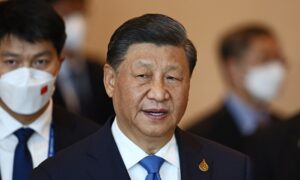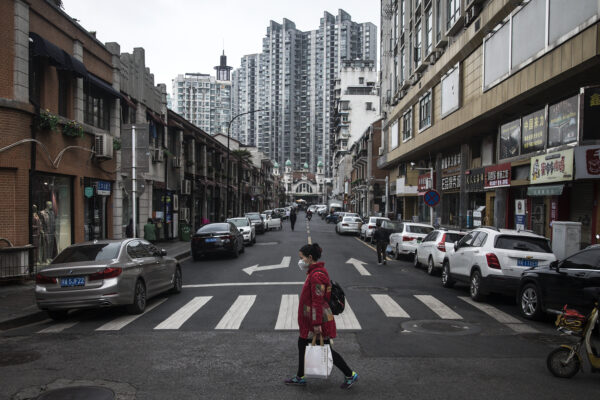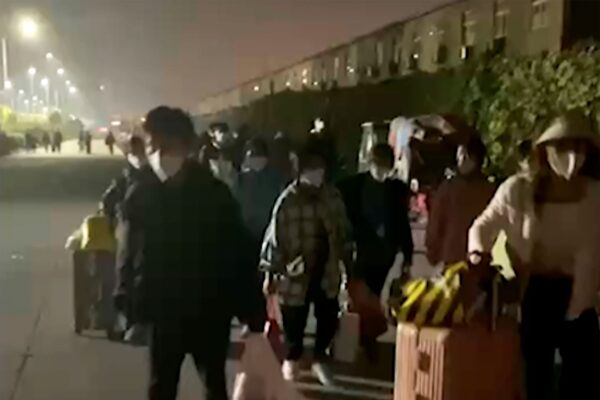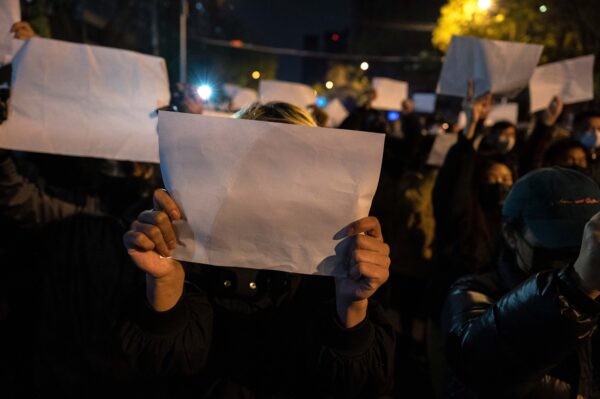Undoing Zero-COVID Reveals the CCP’s Greatest Fear
Commentary The great fear of the leadership of the Chinese Communist Party (CCP) that it will suffer the fate of the Soviet Union was on full display with the abrupt decision to abandon the country’s COVID-zero policy. The unrelenting policy, which had been strictly applied month after month for almost three years, was the personal decision of Chinese leader Xi Jinping who described it in ideological terms. Writing in the Study Times last year, Ma Xiaowei, head of the National Health Commission, stated, “We must take a clear stand against the current wrong ideas such as the so-called ‘coexistence with the virus’ and maintain the zero-COVID strategy.” The reason, according to the chief of the country’s health authority, was that although he consulted medical and scientific experts, “The Central Committee with Xi Jinping at the core” decides, based on an “ideological understanding” or an “ideological problem.” There was a “Xi Jinping Thought” on COVID, he said. There was no confusion about the issue. Xi was applying his commitment to Marxism. Epidemics are caused by capitalism according to Marx and Engels. A consequence of this ideological analysis was the virus must have been introduced to China from a capitalist country. Hence the unsubstantiated claims that American participants in the 2019 Military World Games at Wuhan were responsible. It was another reason why the CCP would not agree to an independent international investigation of the cause of COVID. A women walking in the street in Wuhan, Hubei Province, China, on April 11, 2020. (Getty Images) Why then the sudden change when Xi has repeatedly proclaimed the historic correctness of the CCP’s policies? The Incident That Sparked Wider Dissent The most obvious explanation was the uprisings in China against Xi’s zero-COVID lockdowns of millions of people. The spark for the protests was a fire in an apartment building that had been boarded up under zero-COVID restrictions in Urumqi, the capital city of the westernmost Xinjiang province. It resulted in the deaths of 44 people. News of the event quickly spread via social media, leading to protests in many Chinese cities. The most potent was in Shanghai, where protesters gathered on Urumqi Road, the location of many apartment blocks, to lay flowers and demand the removal of the barricades installed around residential buildings during the COVID lockdowns. These protests spread to other cities. Students were prominent, but the crowds have included many ordinary Chinese demonstrating against the harsh policies. People with suitcases and bags leaving from a Foxconn compound in Zhengzhou in central China’s Henan Province on Oct. 29, 2022. (Hangpai Xingyang via AP) Thousands of workers at the Foxconn iPhone factory in Zhengzhou tore down the barricades and engaged in running melees with police. The plant had maintained a closed operation to avoid the COVID restrictions, with labourers living and working in isolation from the rest of the country. Some of the estimated 200,000 workers at the factory, the manufacturing plant that produces half the world’s iPhone, simply walked away, making their way back to distant towns and villages. In Guangzhou, protesters escaped from locked down buildings. In Wuhan, the source of COVID-19, residents tore down huge iron gates that had been erected to lock down streets. The fact that Chinese officials indicated that they would adjust their harsh policies heightened the unrest as lockdowns escalated across the country. Dissent Against Lockdowns Finds a New Target Protests against the COVID policies quickly morphed into anti-Xi Jinping demonstrations. Despite strict laws against dissent, the protestors invented novel means to proclaim their message. Blank sheets of white paper, a traditional symbolic protest against censorship, were displayed by many people. News of the “A4 paper protest” spread, despite Apple having previously acceded to the regime’s demand that its file-sharing AirDrop app be disabled in China. Students at Tsinghua University, one of the nation’s most prestigious academies, called for “freedom of speech, the rule of law and democracy.” Others near Tiananmen Square chanted “we want universal values,” “we don’t want dictatorship,” “we don’t want personality cult.” In Chengdu, people shouted “Chinese people don’t need emperors” and ”no life tenure.” Elsewhere chants of “step down Xi, step down Communist Party” and we “need human rights, need human freedom” filled the air. Drivers honked their horns in support of others displaying their blank white sheets of paper. Despite the efforts of the government censors, news of these events spread across the nation. In the past, protests have occurred over other issues, including against banks, but these demonstrations challenged the system itself. The CCP resorted to its usual tactics: send in the police and blame “anti-China foreign forces” for fermenting the demonstrations and seeking to provoke

Commentary
The great fear of the leadership of the Chinese Communist Party (CCP) that it will suffer the fate of the Soviet Union was on full display with the abrupt decision to abandon the country’s COVID-zero policy.
The unrelenting policy, which had been strictly applied month after month for almost three years, was the personal decision of Chinese leader Xi Jinping who described it in ideological terms.
Writing in the Study Times last year, Ma Xiaowei, head of the National Health Commission, stated, “We must take a clear stand against the current wrong ideas such as the so-called ‘coexistence with the virus’ and maintain the zero-COVID strategy.”
The reason, according to the chief of the country’s health authority, was that although he consulted medical and scientific experts, “The Central Committee with Xi Jinping at the core” decides, based on an “ideological understanding” or an “ideological problem.”
There was a “Xi Jinping Thought” on COVID, he said.
There was no confusion about the issue. Xi was applying his commitment to Marxism.
Epidemics are caused by capitalism according to Marx and Engels.
A consequence of this ideological analysis was the virus must have been introduced to China from a capitalist country. Hence the unsubstantiated claims that American participants in the 2019 Military World Games at Wuhan were responsible.
It was another reason why the CCP would not agree to an independent international investigation of the cause of COVID.

Why then the sudden change when Xi has repeatedly proclaimed the historic correctness of the CCP’s policies?
The Incident That Sparked Wider Dissent
The most obvious explanation was the uprisings in China against Xi’s zero-COVID lockdowns of millions of people. The spark for the protests was a fire in an apartment building that had been boarded up under zero-COVID restrictions in Urumqi, the capital city of the westernmost Xinjiang province. It resulted in the deaths of 44 people.
News of the event quickly spread via social media, leading to protests in many Chinese cities. The most potent was in Shanghai, where protesters gathered on Urumqi Road, the location of many apartment blocks, to lay flowers and demand the removal of the barricades installed around residential buildings during the COVID lockdowns.
These protests spread to other cities. Students were prominent, but the crowds have included many ordinary Chinese demonstrating against the harsh policies.

Thousands of workers at the Foxconn iPhone factory in Zhengzhou tore down the barricades and engaged in running melees with police. The plant had maintained a closed operation to avoid the COVID restrictions, with labourers living and working in isolation from the rest of the country.
Some of the estimated 200,000 workers at the factory, the manufacturing plant that produces half the world’s iPhone, simply walked away, making their way back to distant towns and villages.
In Guangzhou, protesters escaped from locked down buildings. In Wuhan, the source of COVID-19, residents tore down huge iron gates that had been erected to lock down streets.
The fact that Chinese officials indicated that they would adjust their harsh policies heightened the unrest as lockdowns escalated across the country.
Dissent Against Lockdowns Finds a New Target
Protests against the COVID policies quickly morphed into anti-Xi Jinping demonstrations. Despite strict laws against dissent, the protestors invented novel means to proclaim their message.
Blank sheets of white paper, a traditional symbolic protest against censorship, were displayed by many people. News of the “A4 paper protest” spread, despite Apple having previously acceded to the regime’s demand that its file-sharing AirDrop app be disabled in China.
Students at Tsinghua University, one of the nation’s most prestigious academies, called for “freedom of speech, the rule of law and democracy.”
Others near Tiananmen Square chanted “we want universal values,” “we don’t want dictatorship,” “we don’t want personality cult.” In Chengdu, people shouted “Chinese people don’t need emperors” and ”no life tenure.”
Elsewhere chants of “step down Xi, step down Communist Party” and we “need human rights, need human freedom” filled the air. Drivers honked their horns in support of others displaying their blank white sheets of paper. Despite the efforts of the government censors, news of these events spread across the nation.
In the past, protests have occurred over other issues, including against banks, but these demonstrations challenged the system itself.
The CCP resorted to its usual tactics: send in the police and blame “anti-China foreign forces” for fermenting the demonstrations and seeking to provoke a “colour revolution,” to which social media wits asked if by “foreign forces” they meant Marx and Engels?

Interestingly, the CCP has since sought to claim that the abrupt policy reversal was a decision of the CCP Central Committee, presided over by Xi Jinping, on Nov. 10. This was before the fire in Urumqi and the protests at the iPhone factory in Zhengzhou.
This narrative conflicts with their previous claim that the policy was abandoned on Nov. 7.
Significantly, it was contradicted by the Chinese state-owned media CCTV’s account of the Nov. 10 meeting.
An English translation of the meeting report includes the insistence that “we must concentrate our efforts to fight the battle against the epidemic in key areas, take more resolute and decisive measures to tackle the problem, curb the spread of the epidemic as soon as possible, and restore normal production and living order as soon as possible.”
The meeting further urged the adherence “to scientific and precise prevention and control”—hardly the abandonment of the zero-COVID policy that the CCP now claims it authorised.
The most likely reason is that Xi Jinping abandoned the policy because of the rising protests that threatened to undermine the regime.
He feared they would lead to the demise of the CCP.
Views expressed in this article are the opinions of the author and do not necessarily reflect the views of The Epoch Times.












